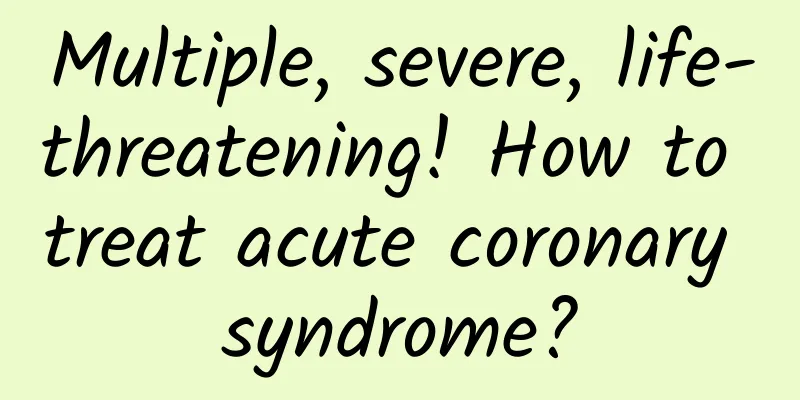Multiple, severe, life-threatening! How to treat acute coronary syndrome?

|
Author: Chen Mulei, Chief Physician, Beijing Chaoyang Hospital, Capital Medical University Reviewer: Jin Mei, Chief Physician, Beijing Anzhen Hospital, Capital Medical University In recent years, with the improvement of living standards, the incidence of diseases such as hypertension, diabetes, hyperlipidemia, etc. has gradually increased, and acute coronary syndrome is closely related to these diseases, so the incidence of acute coronary syndrome is also on the rise. What is acute coronary syndrome? What are the causes? How to treat it? Let's take a look. 1. What is acute coronary syndrome? In principle, acute coronary syndrome is not a disease, but a general term for a group of diseases, just like fruits, which are a general term including peaches, apples, pears, etc. Acute coronary syndrome includes four major categories, namely unstable angina, non-ST-segment elevation myocardial infarction, ST-segment elevation myocardial infarction and sudden myocardial death. They are all caused by the instability of the coronary artery, which induces vascular stenosis or plaque formation to block the blood vessels, thus causing myocardial ischemia. Figure 1 Original copyright image, no permission to reprint We know that the heart is a pump that supplies blood to the whole body, just like the engine of a car. However, the heart itself also needs blood supply. If there are sudden changes in the arteries that supply blood to the heart, such as stenosis or occlusion, it will affect the blood supply to the myocardium, and the contraction of the heart will be affected, thereby affecting the function of the heart. This sudden change in the heart and blood vessels that affects the heart's blood supply is called acute coronary syndrome. 2. What causes acute coronary syndrome? In terms of etiology, acute coronary syndrome can be caused by structural abnormalities. For example, arteriosclerosis causes aggravated vascular stenosis. On the basis of this stenosis and plaque, the plaque suddenly ruptures, or some ulcers form on the surface, and blood clots grow on the surface, so that its lumen becomes smaller and smaller. When the sudden change occurs, the lumen can even be completely blocked, causing the heart to lose blood supply. We know that there is a saying in traditional Chinese medicine that "if there is no circulation, there will be pain." Patients may have symptoms such as chest tightness and chest pain. This is the process of acute coronary syndrome. Of course, there is also a more special situation. The blood vessels are good and relatively unobstructed, without fixed stenosis. However, under the stimulation of certain factors, the blood vessels spasm and contract, which can also cause poor distal blood supply, insufficient myocardial blood supply, and cause cardiac ischemia. This is also a manifestation of acute coronary syndrome. The most common is vascular stenosis caused by atherosclerosis. Figure 2 Original copyright image, no permission to reprint There are many factors that cause atherosclerosis, including genetic factors. If a person's relatives, especially parents, have suffered from coronary heart disease in their early years, then the probability of him developing coronary heart disease will be much higher. At the same time, if he has some bad habits, such as smoking and drinking, and then has complications such as hypertension, diabetes, hyperlipidemia, etc., it will cause the damage to the artery wall to gradually worsen. If he is not aware of this situation and does not seek medical treatment and medication in time to stop the occurrence and development of this injury process, it will eventually become more and more serious, and suddenly explode when it accumulates to a certain level, which may induce an acute coronary syndrome event. This kind of incident is quite dangerous and may be life-threatening if not treated promptly. Some patients, even if they have received timely treatment and have passed the acute phase, will suffer repeated attacks if they do not adhere to medication treatment. 3. How to treat acute coronary syndrome? The treatment of acute coronary syndrome should be divided into two parts: One is the treatment in the acute phase, which is to relieve symptoms and save lives. When there is severe stenosis, the blood vessels should be opened through stents or surgical methods. Of course, there are some patients, such as those with completely blocked blood vessels, that is, ST-segment elevation myocardial infarction. The blood vessels can be opened by drug thrombolysis, but drug thrombolysis will increase the risk of bleeding and has relatively large side effects. In particular, about 1% of patients may suffer from intracranial hemorrhage, which is also a very dangerous disease and may be life-threatening. Another thing is that after thrombolysis, it can only dissolve small blood clots. If the patient still has a very large plaque, this plaque cannot be removed by thrombolytic drugs, so it is not sufficient to treat the disease. Therefore, after thrombolysis, angiography is still needed to see if there is severe stenosis, and interventional treatment is also needed. Therefore, if intervention can be done directly, it may be better to get it done in one step. Another method is emergency bypass surgery, but the mortality rate of emergency bypass surgery is relatively high. At the same time, the technology of interventional treatment is getting better and better, and many lesions can be treated, so emergency bypass surgery is performed less and less. From the perspective of emergency treatment, there are several methods, including thrombolysis, intervention, and bypass surgery. If the patient of acute coronary syndrome has passed the acute phase, he becomes a patient with coronary heart disease and needs long-term treatment, which we call secondary prevention treatment. This involves many drugs, including antiplatelet drugs, lipid-regulating drugs, antihypertensive drugs, hypoglycemic drugs, etc. We need to educate patients in all aspects so that they can adhere to medication, so as to prevent the recurrence of acute coronary syndrome. So it does not mean that if the acute phase is successfully passed, the patient will not have problems in the future. If he fails to do a good job of secondary prevention of coronary heart disease, problems will arise in the future, and each time will be more serious than the last. After multiple occurrences, the heart will be riddled with holes, causing great harm to the patient's health. |
Recommend
Exercise: What is the expert consensus?
One of the most unforgettable details of the Spri...
How long does it take for the egg to be released after the follicle ruptures?
I believe everyone should have a certain understa...
What if you catch a cold during confinement? You still need to eat to increase your immunity
Women who catch a cold during the confinement per...
What should I do if I don’t get paid because of the epidemic? What side jobs can I use to make money during the epidemic?
Recently, due to the epidemic, many people are tr...
Is delayed menstruation caused by lack of blood in the body? Is it a distress signal from the body that menstruation is delayed by five days every month?
gossip A few days ago, "It turns out that de...
Will there be two bars for false pregnancy?
For newlyweds, building a happy home is a very in...
How to recover from bladder prolapse after childbirth
Some women experience symptoms such as bladder sl...
What is cervical ablation surgery?
Cervical ablation is a new method for treating ce...
34 weeks of pregnancy check-up items
Entering the 34th week of pregnancy has already i...
Causes of breast pain in women
Many female friends have joined the intrigues of ...
What is the reason for pink leucorrhea?
Leucorrhea is a female vaginal discharge. Under n...
Why is my period still not over after more than 20 days?
Many female friends have to worry about their men...
How painful is induced labor at 6 months?
The risks of induced abortion are relatively high...
Cervical pain? It is important to do five checks
The health of the cervix is related to the heal...
How to treat breast lumps and swollen lymph nodes under the armpit?
Breast lumps are a common disease that occurs in ...









